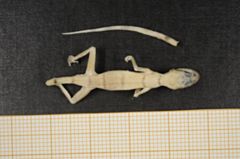Project 2755: M. Simo-Riudalbas, P. Tarroso, T. Papenfuss, T. Al-Sariri, S. Carranza. 2018. Systematics, biogeography and evolution of Asaccus gallagheri (Squamata, Phyllodactylidae) with the description of a new endemic species from Oman. Systematics and Biodiversity. 16:323-339.

Specimen: Asaccus arnoldi Sim?-Riudalbas, Tarroso, Papenfuss, Al-Sariri & Carranza, 2017 (/BMNH2008.961)
View: dorsal
View: dorsal
Abstract
The Hajar Mountains are the highest mountain range in eastern Arabia. Despite being classified as a mountain desert, it is considered one of the top biodiversity hotspots of Arabia. As a result of its relatively old geological origin, complex topography, environmental heterogeneity, and geographical isolation from other mountain ranges, its fauna and flora have diversified significantly producing high levels of endemicity, particularly among reptiles. Several genetic studies indicate that this diversity may still be underestimated, especially within some groups containing morphologically similar species like the nocturnal geckos of the genus Asaccus. These have radiated extensively on both sides of the Gulf of Oman, in the Hajar Mountains and the Zagros Mountains of southwest Asia, and are a good example of the faunal affinities between these two mountain ranges. In the present work, we analyse A. gallagheri, the smallest species of the Arabian radiation, using an unprecedented sampling across its entire distribution range and an integrative approach combining morphological, macroecological and multilocus molecular data with the objective of clarifying its systematics and phylogeography. The results support the presence of two allopatric species within A. gallagheri that split approximately 6 Ma. The newly discovered species is endemic to the Eastern Hajars and is described herein mainly on the basis of its smaller size and high genetic divergence from A. gallagheri. The molecular analyses also uncovered remarkable levels of genetic diversity within both species. The present study highlights the diversity of the genus Asaccus in southeast Arabia and stresses its relevance from a conservation point of view.Read the article »
Article DOI: 10.1080/14772000.2017.1403496
Project DOI: 10.7934/P2755, http://dx.doi.org/10.7934/P2755
| This project contains |
|---|
Download Project SDD File |
Currently Viewing:
MorphoBank Project 2755
MorphoBank Project 2755
- Creation Date:
29 September 2017 - Publication Date:
07 August 2018 - Media downloads: 21

Authors' Institutions ![]()
- Universitat Pompeu Fabra (UPF)
- University of California Berkeley
- Universidade do Porto (University of Porto, CIBIO included)
- Ministry of Environment and Climate Affairs, Oman
Members
| member name | taxa |
specimens |
media | media notes |
| Salvador Carranza Project Administrator | 3 | 204 | 110 | 0 |
Project has no matrices defined.
Project downloads 
| type | number of downloads | Individual items downloaded (where applicable) |
| Total downloads from project | 205 | |
| Project downloads | 184 | |
| Media downloads | 21 | M462435 (1 download); M462324 (1 download); M462325 (1 download); M462337 (1 download); M462336 (1 download); M462334 (1 download); M462335 (1 download); M462332 (1 download); M462333 (1 download); M462330 (1 download); M462331 (1 download); M462328 (1 download); M462329 (2 downloads); M462340 (2 downloads); M462347 (1 download); M462346 (1 download); M462345 (1 download); M462344 (1 download); M462341 (1 download); |
